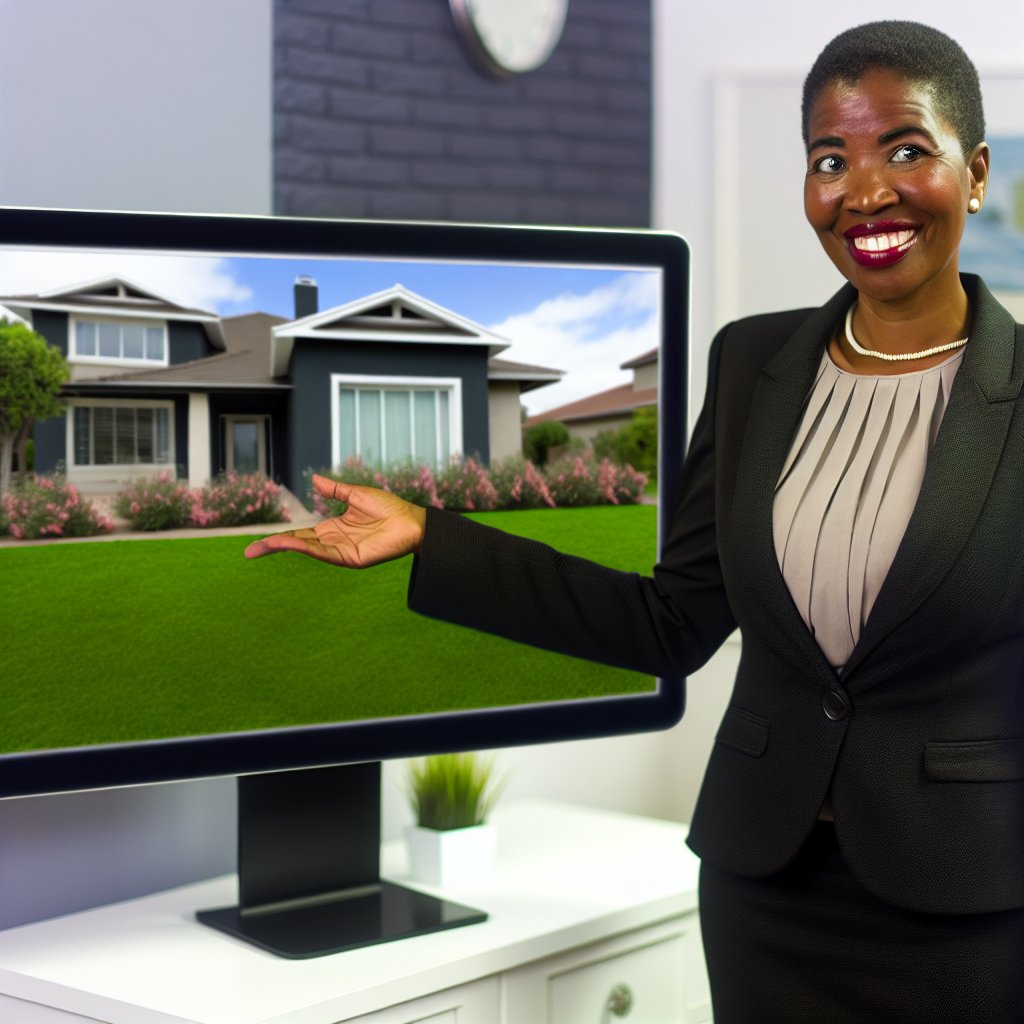Introduction to Virtual Staging
Definition of Virtual Staging
Virtual staging uses technology to enhance property listings.
It creates digital images of spaces, fully furnished and decorated.
This method attracts potential buyers and renters effectively.
Importance of Virtual Staging
Virtual staging plays a crucial role in real estate marketing.
It helps buyers visualize living in a space.
Additionally, it showcases a property’s full potential.
Many buyers cannot envision how an empty home would look furnished.
Thus, virtual staging fills this gap in their perception.
Cost-Effectiveness of Virtual Staging
Opting for virtual staging is often cheaper than traditional staging.
It eliminates costs related to moving furniture and redecorating.
Consequently, sellers save both time and money.
Flexibility and Customization
Virtual staging provides flexibility in design choices.
Real estate agents can customize the look to suit their target market.
Moreover, updates can be made quickly to reflect changing trends.
This adaptability helps properties stand out in competitive markets.
Historical Context: The Evolution of Home Staging in Real Estate
Origins of Home Staging
The concept of home staging emerged in the 1970s in the United States.
It aimed to make properties more marketable and appealing to potential buyers.
Initially, home staging involved decluttering and simple decorating techniques.
Modern Techniques and Approaches
As the market evolved, so did the techniques used in home staging.
By the 1990s, professionals began using furniture, art, and accessories strategically.
This shift enhanced the visual appeal of homes significantly.
The Impact of Technology
Advancements in technology introduced new tools for staging homes.
Virtual staging became popular in the 2000s, offering cost-effective solutions.
These digital tools allow for realistic furniture placement and interior design.
Cultural and Economic Influences
Cultural trends also influenced home staging practices.
Economic factors, such as the housing market’s ups and downs, played a role.
Staging became essential during economic downturns to attract buyers.
Current Trends in Home Staging
Today, home staging is an integral part of real estate marketing strategies.
Homeowners frequently hire professional stagers for expert guidance.
Moreover, virtual staging tools have expanded accessibility for sellers.
This innovation allows for more customized and visually appealing presentations.
Key Features of Virtual Staging Tools: What to Look For
Realistic 3D Rendering
High-quality 3D rendering creates immersive virtual experiences.
This feature helps buyers visualize spaces effectively.
Look for tools that offer custom textures and realistic lighting.
User-Friendly Interface
A user-friendly interface enhances usability for agents and homeowners.
Choose tools that allow quick design modifications with minimal learning.
Simplifying the staging process can save valuable time.
Extensive Furniture and Decor Library
A comprehensive library of furniture options enriches the staging experience.
It provides diverse styles to suit various properties.
Ensure the library is regularly updated with the latest trends.
Integration Capabilities
Integration with real estate platforms boosts efficiency.
Look for tools that sync with MLS systems and listing services.
This feature can streamline the showcasing process for agents.
High-Resolution Image Outputs
High-resolution image outputs showcase properties effectively online.
Sharp visuals can captivate potential buyers or renters.
Check if the tool exports images in various formats for flexibility.
Cost-Effective Solution
Virtual staging is often more affordable than traditional staging.
It eliminates costs associated with physical furniture and decor.
Evaluate the pricing model to ensure it fits within your marketing budget.
Customer Support
Reliable customer support can significantly enhance the user experience.
Choose tools that offer responsive assistance when needed.
Good support can help maximize the effectiveness of your staging efforts.
Trial or Demo Versions
Many staging tools offer trial or demo versions for evaluation.
Testing the features firsthand can help in decision-making.
Take advantage of these options to find the best fit for your needs.
Uncover the Details: Real Estate Market Trends Influencing Home Prices and Values
Benefits of Virtual Staging for Real Estate Agents and Sellers
Cost-Effectiveness
Virtual staging significantly reduces costs compared to traditional staging.
It eliminates the need for furniture rental and physical labor.
Sellers can showcase their properties without high upfront expenses.
Enhanced Visual Appeal
Virtual staging creates stunning visuals that attract potential buyers.
High-quality images enhance the online presence of the property.
This increased visual appeal helps listings stand out in a crowded market.
Flexibility in Design
Agents can customize design elements easily to suit different buyer preferences.
They can experiment with multiple styles without physical constraints.
This flexibility leads to a more tailored presentation of the property.
Time Efficiency
Virtual staging saves time in preparing a property for the market.
There’s no need for logistics related to moving furniture and decor.
This allows agents and sellers to list properties much faster.
Improved Buyer Engagement
Stunning visuals draw in potential buyers, leading to more inquiries.
Well-staged properties create an emotional connection with viewers.
This engagement can drive higher offers from interested parties.
Broader Marketing Reach
Virtual staging aids in producing shareable, marketable content.
Staged images can be utilized across various platforms effectively.
This broadens the marketing reach, attracting more potential buyers.
Uncover the Details: Mastering Email Campaign Tactics For Generating Sustainable Real Estate Leads
Comparison of Virtual Staging vs. Traditional Staging: Pros and Cons
Understanding Traditional Staging
Traditional staging involves physically furnishing a property for sale.
It often showcases the property in its best light.
Real stagers use furniture, artwork, and decor to appeal to buyers.
Typically, this method requires significant time and effort.
Additionally, it entails costs for rental furniture and staging services.
Advantages of Traditional Staging
- Provides an authentic experience of the space.
- Enhances the property’s aesthetic appeal significantly.
- Helps potential buyers visualize living in the space.
- May lead to quicker sales and higher offers.
Challenges of Traditional Staging
- High costs can be a barrier for sellers.
- Requires physical labor and logistics for setup.
- Certain styles may not resonate with all buyers.
- Can take time to arrange and complete staging.
Exploring Virtual Staging
Virtual staging uses digital technology to furnish spaces online.
This process allows for creative flexibility in showcasing properties.
It can manipulate images to depict various styles and arrangements.
Importantly, it eliminates the need for physical staging logistics.
Virtual staging is often more cost-effective than traditional methods.
Advantages of Virtual Staging
- Reduces overall staging costs significantly.
- Offers greater design variety and customization.
- Enhances property appeal quickly without physical setup.
- Can reach a wider audience through online marketing.
Challenges of Virtual Staging
- Buyers may remain skeptical of digitally altered images.
- Does not provide a physical walkthrough experience.
- Some companies may deliver lower quality graphics.
- Potential misalignment with buyer expectations.
Choosing the Right Options
Deciding between virtual and traditional staging depends on various factors.
Consider the property, budget, and target market when making this choice.
In some cases, a hybrid approach may be ideal.
Integrating both methods can leverage their strengths effectively.
Ultimately, the goal is to enhance the property showcasing experience.
Find Out More: Effective Content Marketing Strategies To Attract Quality Real Estate Leads
Popular Virtual Staging Software: An Overview of Top Tools
Introduction to Virtual Staging Tools
Virtual staging tools enhance real estate marketing strategies.
These software applications allow professionals to showcase properties digitally.
They create realistic images without the need for physical staging.
As a result, agents can save time and money while appealing to buyers.
Top Virtual Staging Software
Several notable virtual staging tools dominate the market today.
Each offers unique features that cater to different needs.
Virtual Staging Solutions
- BoxBrownie: Known for its exceptional image quality.
- Virtual Staging Solutions: Offers a variety of furniture options.
- Homestyler: Provides easy-to-use design tools and layouts.
Specialized Tools
- Keyend: Focuses on 3D visualization.
- Cocoflo: Emphasizes outdoor spaces and landscaping.
- Roomvu: Integrates comprehensive marketing features.
Benefits of Using Virtual Staging Software
Using virtual staging software has numerous advantages.
Firstly, it enhances property visual appeal significantly.
Additionally, it allows for creative freedom in design choices.
Moreover, these tools can shorten the time properties spend on the market.
This efficiency can lead to quicker sales and happier clients.
Challenges and Considerations
Despite its benefits, virtual staging comes with some challenges.
For instance, achieving a realistic look requires skill and experience.
Furthermore, there can be a learning curve with new software.
Agents must also manage client expectations regarding virtual images.
Learn More: Harnessing Data Analytics Tools For Targeted Real Estate Market Insights

Best Practices for Effective Virtual Staging
Choose the Right Software
Select virtual staging software that aligns with your needs.
Consider software that offers high-quality visuals.
Additionally, look for tools with user-friendly interfaces.
Evaluate different options to find the best fit for your projects.
Use High-Quality Images
Always start with high-resolution images of the property.
Clear and well-lit photos showcase the space effectively.
Incorporate images that capture the essence of each room.
Good quality images make the staging process more impactful.
Be Mindful of Style and Cohesion
Ensure that the furniture and decor match the style of the home.
Maintaining a cohesive look enhances the overall appeal.
Consider the target market when choosing furniture styles.
For instance, modern decor may attract younger buyers.
Highlight Key Features
Focus on unique aspects of the property during staging.
Use furniture arrangement to draw attention to these features.
Arrange seating areas around a fireplace or window.
This creates inviting focal points for potential buyers.
Keep It Simple
Avoid overcrowding the space with too much furniture.
Less is often more in virtual staging.
Choose a few key pieces to create a balanced look.
This approach allows viewers to envision their style in the space.
Test Different Arrangements
Experiment with various furniture layouts.
Try different styles until you find the most appealing arrangement.
Use the software’s features to visualize changes easily.
This flexibility allows for creativity and optimization.
Utilize Natural Light
Enhance photos by making the most of natural light.
Proper lighting can make the space feel larger and more inviting.
Consider staging during times of day with optimal sunlight.
Adjust the lighting in your digital staging to maintain brightness.
Gather Feedback
Seek feedback from colleagues or clients on your virtual staging.
Different perspectives can provide valuable insights.
Use this feedback to refine your staging techniques.
Continuous improvement helps enhance your staging effectiveness.
Case Studies: Successful Real Estate Sales Utilizing Virtual Staging
The Impact of Virtual Staging on Property Sales
Virtual staging transforms empty spaces into appealing environments.
This technique attracts potential buyers by creating visual appeal.
Consequently, properties sell faster and often at higher prices.
Case Study: The Johnson Residence
The Johnsons struggled to sell their home for months.
After implementing virtual staging, interest surged immediately.
Buyers easily imagined their lives in the beautifully staged rooms.
Within weeks, the Johnsons received multiple offers.
Case Study: Downtown Loft
A downtown loft sat vacant for an extended period.
After virtual staging, the loft showcased its unique features effectively.
The open floor plan appeared inviting and stylish.
Ultimately, this approach attracted a buyer who appreciated the aesthetics.
Benefits of Utilizing Virtual Staging
One key advantage is cost-effectiveness compared to physical staging.
Virtual staging also allows for quick adjustments to designs.
Furthermore, it can highlight various styles to appeal to diverse buyers.
Implementing Virtual Staging Successfully
Choose a reliable virtual staging provider for optimal results.
Ensure that the staged images are high quality and realistic.
Additionally, integrate those images into effective marketing strategies.
This boosts visibility across online listings and social media platforms.
Future Trends in Virtual Staging: Innovations and Predictions
Advancements in Technology
Emerging technologies significantly enhance virtual staging tools.
For example, augmented reality (AR) will transform property showcasing.
Homebuyers can visualize spaces with added furniture and decor in real time.
Moreover, artificial intelligence (AI) will streamline design processes.
AI algorithms will provide personalized staging solutions for clients.
Integration with Other Platforms
Virtual staging will increasingly integrate with real estate platforms.
Agents can easily incorporate virtual staging into listings and marketing efforts.
This integration enhances user experience for potential buyers.
Furthermore, social media platforms will leverage virtual staging features.
This allows agents to share beautifully staged homes directly with audiences.
Increased Demand for Customization
Buyers will seek more customization options in virtual staging.
Personalization in design features will become a key selling point.
Clients will want tailored designs that reflect their style and preferences.
This trend will require staging companies to offer diverse options.
Consequently, they must adapt to the growing demands of individual clients.
Environmental Considerations
Sustainability will play a crucial role in future virtual staging.
Companies will adopt eco-friendly practices and materials.
Virtual staging eliminates the need for physical furniture, reducing waste.
Moreover, showcasing sustainable designs will become more popular.
This trend aligns with the increasing consumer awareness of environmental issues.
The Role of Data Analytics
Data analytics will shape the future of virtual staging strategies.
Real estate professionals will rely on data to understand market trends.
Analytics help in identifying buyer preferences and popular styles.
This information allows for more effective staging decisions.
Ultimately, it enhances the appeal of properties on the market.
The Impact of Virtual Staging on Real Estate Marketing
Enhancing Property Appeal
Virtual staging significantly enhances the visual appeal of properties.
It allows potential buyers to visualize each space’s potential.
This technology showcases properties in their best light.
Consequently, homes receive more views and engagement.
Cost Effectiveness
Virtual staging is a cost-effective alternative to traditional staging.
It eliminates the need for physical furniture and decor rentals.
Additionally, agents save on transportation and setup costs.
This method allows for flexible and timely property showcasing.
Marketing Flexibility
Virtual staging offers flexibility in marketing strategies.
Agents can easily update images for seasonal promotions or events.
This capability keeps listings fresh and appealing.
Moreover, sellers can tailor images to target specific buyer demographics.
Improved Online Presence
A strong online presence is vital in today’s real estate market.
High-quality virtual staging enhances digital listings significantly.
Compelling visuals attract a wider audience on social media platforms.
This can lead to increased inquiries and potential sales.
Realistic Visualization
Virtual staging allows for realistic visualization of spaces.
Buyers can see how different layouts and styles would look.
This helps buyers connect emotionally with the property.
As a result, it can expedite the decision-making process.
Future Transformations in Marketing
Virtual staging reshapes real estate marketing strategies.
Its ability to enhance visual appeal impacts buyer interest significantly.
As technology advances, virtual staging will become even more integrated into listings.
This could lead to a transformative shift in how properties are marketed.
Additional Resources
Real Estate Artificial Intelligence in Real Estate Technology | Sierra …




